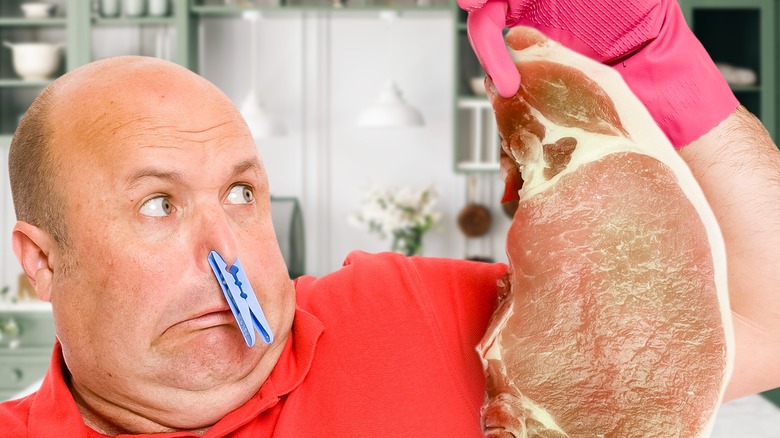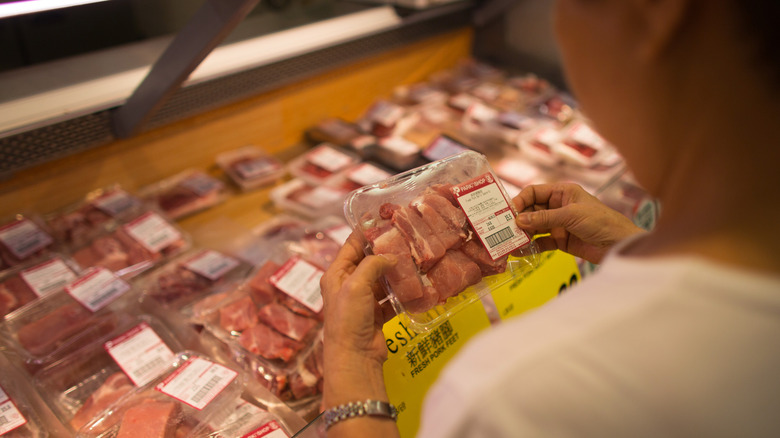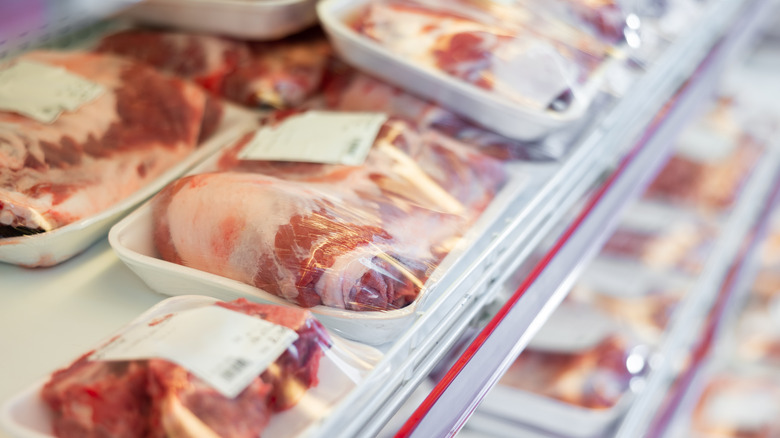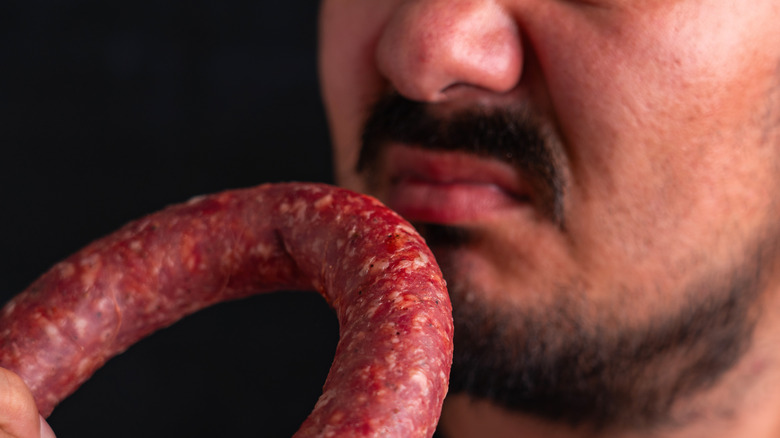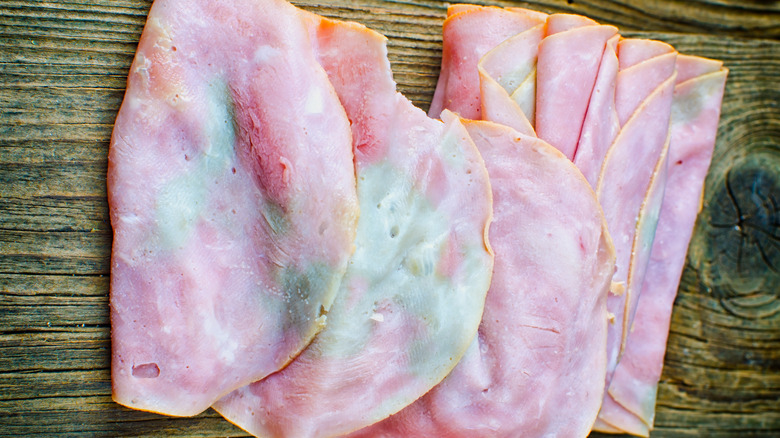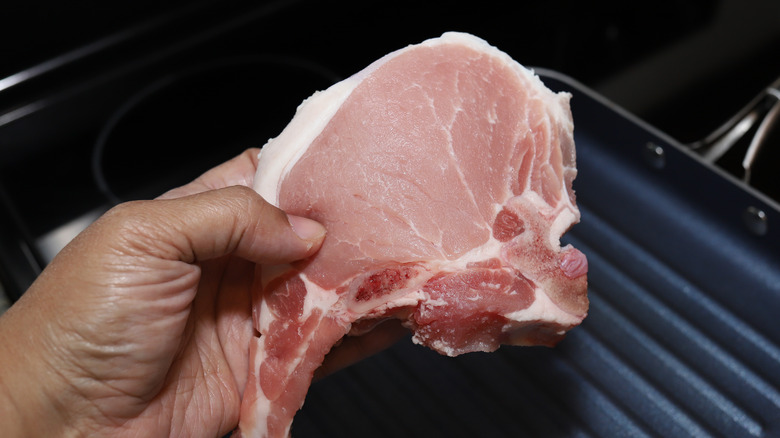5 Warning Signs Your Pork Has Gone Bad
There's nothing like a long marinated, slow-roasted pork shoulder finally out of the oven with fall-off-the-bone tenderness. Double-smoked bacon crackling in a hot pan of its own fat and a few drops of olive oil is one of life's simple pleasures. However, there's nothing like food poisoning to ruin a great meal.
It's widely accepted that uncooked pork can be harmful due to illness-inducing bacteria like Trichinella spiralis, salmonella, and Listeria — parasites leading to abdominal pain, an inability to keep food down, and a number of flu-like symptoms including fatigue, soreness, and general discomfort.
Trichinella spiralis is caused by microscopic tapeworms that cause severe infections, and the aforementioned tapeworms can start burrowing anywhere from one day to a week post-meal. Although treatable, trichinosis could be an eight-week ordeal before you start feeling like yourself. Modern agricultural methods have made trichinosis less of a concern in the Global North, but some 28,000 people around the world still die as a result. As concerning as raw pork can be, it's just as easy for cooked pork to cause health problems as well.
Without an understanding of how long leftover meats really last in the fridge, one of the biggest mistakes people make when defrosting meat is the assumption it's safe to eat. To help you avoid this misery, we've compiled a list of surefire ways to tell if your pork has gone bad before, during, and after cooking it.
It's past its expiry date
The expiry date notice on your packaged pork isn't just there for decoration or to take as a mere suggestion. It's your first real clue as to whether your meat is spoiled. The sell-by-date or expiration date on your pork — typically within three to five days of buying it — should be a safe indicator for your grocer to take something off the shelves; sometimes, these things get missed.
You also shouldn't confuse the sell-by-date with the use-by-date, the latter being the USDA's tip-off as to when you should freeze your pork for later consumption if you're not going to eat it on time. The sell-by-date is a non-negotiable situation, the use-by-date offers a little more flexibility in terms of when your pork can actually be consumed. As long as your refrigerator is 40 degrees Fahrenheit or less, you should be able to tack an extra one or two days onto your use-by consumption date for fresh pork.
Freezing your pork is also another way to prolong the shelf life of your pork. Subzero temperatures can keep your meat edible for an indefinite period, but according to the USDA, four to six months is your best window to preserve your pork's quality. Remember, it's not just about how long you can save your pork chops without them rotting. You should also be mindful of how long they can be kept in the freezer while still retaining their flavor and juiciness.
Puffy packaging
Puffy packaging can be a bad sign when it comes to pork or, really, any type of meat. When your food packaging is bloated, it can mean that bacteria has entered the chat and your pork. Sometimes, there can be more benign reasons for this bloating, however. Higher altitude regions can lead to puffy packaging due to competing higher internal and lower external air pressures, and modified atmosphere packaging or MAP, where a mix of gases is used in the packaging process to increase the longevity of the meat product, can also cause package bloating without contamination.
Outside of the aforementioned reasons, however, inflated packaging is a sign of bacteria multiplying inside, as it is a release of carbon dioxide created by the microbial contamination. According to Food Safety Magazine, the three main types of bacteria causing puffy packaging are coliforms, lactic acid, and yeast. Coliform bacteria are typically caused by unsanitary abattoirs or meat-packing plants and live in the gastrointestinal tracts of pigs. Heat resistant but highly susceptible to cold, refrigeration usually gets rid of coliforms. On the other hand, lactic acid bacteria can actually multiply in the cold, so refrigeration at the grocery store or at home won't have much of an effect on the contamination level. Also, yeast microbes can form through airborne transmission, survive cold temperatures, and actually create so much gas that they can pop plastic packaging.
It doesn't pass the smell test
We've talked about how bacteria can release carbon dioxide that bloats the packaging of your pork. That bloated packaging can also come with an off-putting smell reminiscent of rotten dairy. While safe meat should carry no discernible smell, the use of some preservatives in meat can actually mask scents that might otherwise warn you of the bacteria present.
The reason bacteria release that bad smell is based on microbial chemistry. What you're smelling is either the bacteria's natural odor or the odor emitted by the pork as it's devoured by microbes. Some scientific circles even theorize that bacteria have evolved to better compete with humans for food by excreting smells naturally abhorrent to us. Whatever the case, it's again worth noting that smell alone shouldn't be the sole or final indicator of safe pork since some bacteria don't actually release any offensive scents.
As per Scientific American, boar taint — a natural smell reminiscent of perspiration or excrement that comes from the testes of pigs — can also make your smell test less accurate. In fact, boar taint is such a regular phenomenon that even Big Pharma is attempting to tackle it for pork consumers. Pfizer's animal health division has concocted a pig immunization called Improvac that generates antibodies to limit the creation of the funky compounds that produce boar taint odors. Regardless, it's still a safe bet that if your pork is smelly, you're best to leave it alone.
It looks off
If you eat with your eyes first, you'd better make sure that what's before you appears safe at first sight. Where raw pork is concerned, that means looking for meat with a healthy dark pink hue and bone-white marbles of fat interspersed throughout. Speaking of bone, if your pork is a bone-in cut, you don't want to see any off-color spotting on it. Excess moisture condensing in the package is also a warning sign your pork has gone bad.
We know that an undercooked piece of pork can lead to food-borne illnesses, so to mitigate the possibility of that, be sure to take a look at its insides first. In a Daily Mail article, a U.K. food security expert suggests that there should be no visible pinkness post-cooking nor color in the juices after cutting into your pork. In the United States, there is a different opinion about the necessary doneness of pork.
When considering whether pink pork is safe to eat or not, the United States Department of Agriculture (USDA) has determined that pork roast, pork loin, and pork chops are okay so long as the internal temperature hits 145 degrees Fahrenheit. This lowers the previous USDA suggestion of 160 degrees Fahrenheit which was changed to reflect the leaner nature of modern cuts of pork that are more susceptible to overcooking. Defrosted pork that appears dark-colored, devoid of moisture, and tough is freezer-burned. This pork is a hard pass — it will taste exactly how it looks.
It feels wrong
Aside from smell and sight, touch is another sense important to recognizing if pork has gone bad or not. As with the puffy packaging scenario, a viscous, slimy piece of pork is an indication of bacterial microbes spreading through your meat. This usually looks like fungal growth, otherwise known as mold, on the surface of the meat.
As per The Science Notes, this growth can take the appearance of tiny white whiskers along the surface of the meat, which can be produced by a number of different mold types: black spots known as Cladosporium herbarium, white spots, green spots, and of course, a sticky or viscous surface film which aids in keeping the bacteria alive. There are several reasons why your meat can degrade, all starting from the moment the pig is slaughtered. Factors include the bacteria already laying dormant in the animal prior to slaughter, how the animal was processed in the abattoir and packaging plant, its post-packaging storage, or even the stress level of the animal prior to slaughter — animals slaughtered inhumanely tend to deliver lower quality meat — all lead to spoilage.
